Mechanical and Microscopic Characteristics of Polyurethane-Based Pervious Pavement Composites
Abstract
:1. Introduction
2. Aim and Objectives
3. Methods
3.1. Materials and Specimens
3.2. Characterizations
4. Results and Discussion
4.1. Mechanical and Permeability Results
4.2. Microstructural Characteristics
4.2.1. Analysis of Pore Characteristics
4.2.2. Tortuosity Investigation
4.3. Numerical Results
5. Concluding Remarks
- (1)
- Compressive and permeability tests indicated that a combination of aggregate sizes had a significant effect on the pore path tortuosity.
- (2)
- High contents of large-sized aggregate (#2) provoked an increase in the porosity and tortuosity, leading to high water permeability of these specimens.
- (3)
- The specimen with a smaller aggregate size (2.5–10 mm) showed a dense internal structure, though this was not closely associated with the compressive strength development in this sample.
- (4)
- The increased porosity contributed to a decrease in the compressive strength and an increase in the tortuosity, and the effects of the porosity on the tortuosity were insignificant compared to the compressive strength.
Author Contributions
Funding
Institutional Review Board Statement
Informed Consent Statement
Data Availability Statement
Conflicts of Interest
References
- Yang, J.; Jiang, G. Experimental study on properties of pervious concrete pavement materials. Cem. Concr. Res. 2003, 33, 381–386. [Google Scholar] [CrossRef]
- Lu, G.; Liu, P.; Wang, Y.; Faßbender, S.; Wang, D.; Oeser, M. Development of a sustainable pervious pavement material using recycled ceramic aggregate and bio-based polyurethane binder. J. Clean. Prod. 2019, 220, 1052–1060. [Google Scholar] [CrossRef]
- Cui, X.; Zhang, J.; Huang, D.; Liu, Z.; Hou, F.; Cui, S.; Zhang, L.; Wang, Z. Experimental study on the relationship between permeability and strength of pervious concrete. J. Mater. Civ. Eng. 2017, 29, 04017217. [Google Scholar] [CrossRef]
- Neithalath, N. Development and Characterization of Acoustically Efficient Cementitious Materials. Ph.D. Thesis, Purdue University, West Lafayette, IN, USA, 2004. [Google Scholar]
- Mullaney, J.; Lucke, T. Practical review of pervious pavement designs. CLEAN–Soil Air Water 2014, 42, 111–124. [Google Scholar] [CrossRef]
- Zhong, R.; Leng, Z.; Poon, C.-S. Research and application of pervious concrete as a sustainable pavement material: A state-of-the-art and state-of-the-practice review. Const. Build. Mater. 2018, 183, 544–553. [Google Scholar] [CrossRef]
- Scholz, M.; Grabowiecki, P. Review of permeable pavement systems. Build. Environ. 2007, 42, 3830–3836. [Google Scholar] [CrossRef]
- Lee, S.J. A study on factors that influence traffic accident severity in road surface freezing. J. Korean Soc. Precis. Eng. 2017, 32, 150–156. [Google Scholar]
- Li, J.; Zhang, Y.; Liu, G.; Peng, X. Preparation and performance evaluation of an innovative pervious concrete pavement. Const. Build. Mater. 2017, 138, 479–485. [Google Scholar] [CrossRef]
- Zaetang, Y.; Sata, V.; Wongsa, A.; Chindaprasirt, P. Properties of pervious concrete containing recycled concrete block aggregate and recycled concrete aggregate. Const. Build. Mater. 2016, 111, 15–21. [Google Scholar] [CrossRef]
- Lima, M.S.S.; Thives, L.P.; Haritonovs, V.; Gschösser, F. The influence of alternative fillers on the adhesive properties of mastics fabricated with red mud. Materials 2020, 13, 484. [Google Scholar] [CrossRef] [Green Version]
- Güneyisi, E.; Gesoglu, M.; Kareem, Q.; Ipek, S. Effect of different substitution of natural aggregate by recycled aggregate on performance characteristics of pervious concrete. Mater. Struct. 2016, 49, 521–536. [Google Scholar] [CrossRef]
- Ippolito, M.; Mattoni, A.; Pugno, N.; Colombo, L. Failure strength of brittle materials containing nanovoids. Phys. Rev. B 2007, 75, 224110. [Google Scholar] [CrossRef] [Green Version]
- Iskander, M.; Shrive, N. On the fracture of brittle and quasi-brittle materials subject to uniaxial compression and the interaction of voids on cracking. Const. Build. Mater. 2021, 290, 123217. [Google Scholar] [CrossRef]
- Chindaprasirt, P.; Hatanaka, S.; Chareerat, T.; Mishima, N.; Yuasa, Y. Cement paste characteristics and porous concrete properties. Const. Build. Mater. 2008, 22, 894–901. [Google Scholar] [CrossRef]
- Liu, M.; Xia, J.; Chin, C.S.; Liu, Z. Improving the properties of recycled aggregate pervious pavement blocks through bio-mineralization. Const. Build. Mater. 2020, 262, 120065. [Google Scholar] [CrossRef]
- Huang, B.; Wu, H.; Shu, X.; Burdette, E.G. Laboratory evaluation of permeability and strength of polymer-modified pervious concrete. Const. Build. Mater. 2010, 24, 818–823. [Google Scholar] [CrossRef]
- Giustozzi, F. Polymer-modified pervious concrete for durable and sustainable transportation infrastructures. Const. Build. Mater. 2016, 111, 502–512. [Google Scholar] [CrossRef]
- Rasol, M.; Pérez-Gracia, V.; Fernandes, F.M.; Pais, J.C.; Santos-Assunçao, S.; Santos, C.R.; Sossa, V. GPR laboratory tests and numerical models to characterize cracks in cement concrete specimens, exemplifying damage in rigid pavement. Measurement 2020, 158, 107662. [Google Scholar] [CrossRef]
- Solla, M.; Lagüela, S.; Riveiro, B.; Lorenzo, H. Non-destructive testing for the analysis of moisture in the masonry arch bridge of Lubians (Spain). Struct. Contr. Health Montrg. 2013, 20, 1366–1376. [Google Scholar] [CrossRef]
- Sossa, V.; Pérez-Gracia, V.; González-Drigo, R.; A Rasol, M. Lab nondestructive test to analyze the effect of corrosion on ground penetrating radar scans. Remote Sens. 2019, 11, 2814. [Google Scholar] [CrossRef] [Green Version]
- Rasol, M.A.; Pérez-Gracia, V.; Solla, M.; Pais, J.C.; Fernandes, F.M.; Santos, C. An experimental and numerical approach to combine Ground Penetrating Radar and computational modeling for the identification of early cracking in cement concrete pavements. NDT E Int. 2020, 115, 102293. [Google Scholar] [CrossRef]
- Rasol, M.A.; Pérez-Gracia, V.; Fernandes, F.M.; Pais, J.C.; Solla, M.; Santos, C. NDT assessment of rigid pavement damages with ground penetrating radar: Laboratory and field tests. Int. J. Pavement Eng. 2020, 1–16. [Google Scholar] [CrossRef]
- Lu, G.; Renken, L.; Li, T.; Wang, D.; Li, H.; Oeser, M. Experimental study on the polyurethane-bound pervious mixtures in the application of permeable pavements. Const. Build. Mater. 2019, 202, 838–850. [Google Scholar] [CrossRef]
- Cho, J.; Jang, H.G.; Kim, S.Y.; Yang, B. Flexible and coatable insulating silica aerogel/polyurethane composites via soft segment control. Compos. Sci. Technol. 2019, 171, 244–251. [Google Scholar] [CrossRef]
- Leng, C.; Lu, G.; Gao, J.; Liu, P.; Xie, X.; Wang, D. Sustainable green pavement using bio-based polyurethane binder in tunnel. Materials 2019, 12, 1990. [Google Scholar] [CrossRef] [Green Version]
- Neptune, A.I.; Putman, B.J. Effect of aggregate size and gradation on pervious concrete mixtures. ACI Mater. J. 2010, 107, 625. [Google Scholar]
- ASTM C39/C39M-21. Standard Test Method for Compressive Strength of Cylindrical Concrete Specimens; ASTM International: West Conshohocken, PA, USA, 2021. [Google Scholar]
- Chung, S.-Y.; Abd Elrahman, M.; Kim, J.-S.; Han, T.-S.; Stephan, D.; Sikora, P. Comparison of lightweight aggregate and foamed concrete with the same density level using image-based characterizations. Const. Build. Mater. 2019, 211, 988–999. [Google Scholar] [CrossRef]
- Ghanbarian, B.; Hunt, A.G.; Sahimi, M.; Ewing, R.P.; Skinner, T.E. Percolation theory generates a physically based description of tortuosity in saturated and unsaturated porous media. Soil Sci. Soc. Am. J. 2013, 77, 1920–1929. [Google Scholar] [CrossRef]
- Chung, S.-Y.; Han, T.-S.; Kim, S.-Y. Reconstruction and evaluation of the air permeability of a cement paste specimen with a void distribution gradient using CT images and numerical methods. Const. Build. Mater. 2015, 87, 45–53. [Google Scholar] [CrossRef]
- Xu, W.; Jiao, Y. Theoretical framework for percolation threshold, tortuosity and transport properties of porous materials containing 3D non-spherical pores. Int. J. Eng. Sci. 2019, 134, 31–46. [Google Scholar] [CrossRef]
- Yang, B.J.; Cho, K.J.; Kim, G.M.; Lee, H.K. Effect of CNT agglomeration on the electrical conductivity and percolation threshold of nanocomposites: A micromechanics-based approach. Comp. Model. Eng. Sci. 2014, 103, 343–365. [Google Scholar]
- Shanti, N.O.; Chan, V.W.; Stock, S.R.; De Carlo, F.; Thornton, K.; Faber, K.T. X-ray micro-computed tomography and tortuosity calculations of percolating pore networks. Acta Mater. 2014, 71, 126–135. [Google Scholar] [CrossRef]
- Zeng, W.; Church, R.L. Finding shortest paths on real road networks: The case for A. Int. J. Geogr. Inf. Sci. 2009, 23, 531–543. [Google Scholar] [CrossRef]
- Yang, B.; Ha, S.; Pyo, S.; Lee, H. Mechanical characteristics and strengthening effectiveness of random-chopped FRP composites containing air voids. Compos. B. Eng. 2014, 62, 159–166. [Google Scholar] [CrossRef]
- Michailidis, N.; Stergioudi, F.; Omar, H.; Papadopoulos, D.; Tsipas, D. Experimental and FEM analysis of the material response of porous metals imposed to mechanical loading. Colloids Surf. A Physicochem. Eng. Asp. 2011, 382, 124–131. [Google Scholar] [CrossRef]
- Tennis, P.D.; Leming, M.L.; Akers, D.J. Pervious Concrete Pavements; Portland Cement Association: Skokie, IL, USA, 2004. [Google Scholar]
- Al-sallami, Z.H.A.; Marshdi, Q.S.R.; Mukheef, R.A.A.H. Effect of cement replacement by fly ash and epoxy on the properties of pervious concrete. Asian J. Civil Eng. 2020, 21, 49–58. [Google Scholar] [CrossRef]
- Chen, Y.; Wang, K.; Wang, X.; Zhou, W. Strength, fracture and fatigue of pervious concrete. Const. Build. Mater. 2013, 42, 97–104. [Google Scholar] [CrossRef]
- Gong, X.; Bustillo, J.; Blanc, L.; Gautier, G. FEM simulation on elastic parameters of porous silicon with different pore shapes. Int. J. Solids Struct. 2020, 190, 238–243. [Google Scholar] [CrossRef]
- Park, S.M.; Yang, B.; Kim, B.; Ha, S.; Lee, H.-K. Structural strengthening and damage behaviors of hybrid sprayed fiber-reinforced polymer composites containing carbon fiber cores. Int. J. Damage Mech. 2017, 26, 358–376. [Google Scholar] [CrossRef]
- Yang, B.; Na, S.; Jang, J.G.; Kim, H.; Lee, H.-K. Thermo-mechanical analysis of road structures used in the on-line electric vehicle system. Struct. Eng. Mech. 2015, 53, 519–536. [Google Scholar] [CrossRef]
- Michailidis, N.; Stergioudi, F.; Omar, H.; Tsipas, D. FEM modeling of the response of porous Al in compression. Comput. Mater. Sci. 2010, 48, 282–286. [Google Scholar] [CrossRef]
- Chen, X.; Wu, S.; Zhou, J. Influence of porosity on compressive and tensile strength of cement mortar. Const. Build. Mater. 2013, 40, 869–874. [Google Scholar] [CrossRef]
- Kim, S.Y.; Jang, J.-U.; Haile, B.F.; Lee, M.W.; Yang, B. Swarm intelligence integrated micromechanical model to investigate thermal conductivity of multi-walled carbon nanotube-embedded cyclic butylene terephthalate thermoplastic nanocomposites. Compos. Part A Appl. Sci. Manuf. 2020, 128, 105646. [Google Scholar] [CrossRef]
- Liu, D.-M. Influence of porosity and pore size on the compressive strength of porous hydroxyapatite ceramic. Ceram. Int. 1997, 23, 135–139. [Google Scholar] [CrossRef]
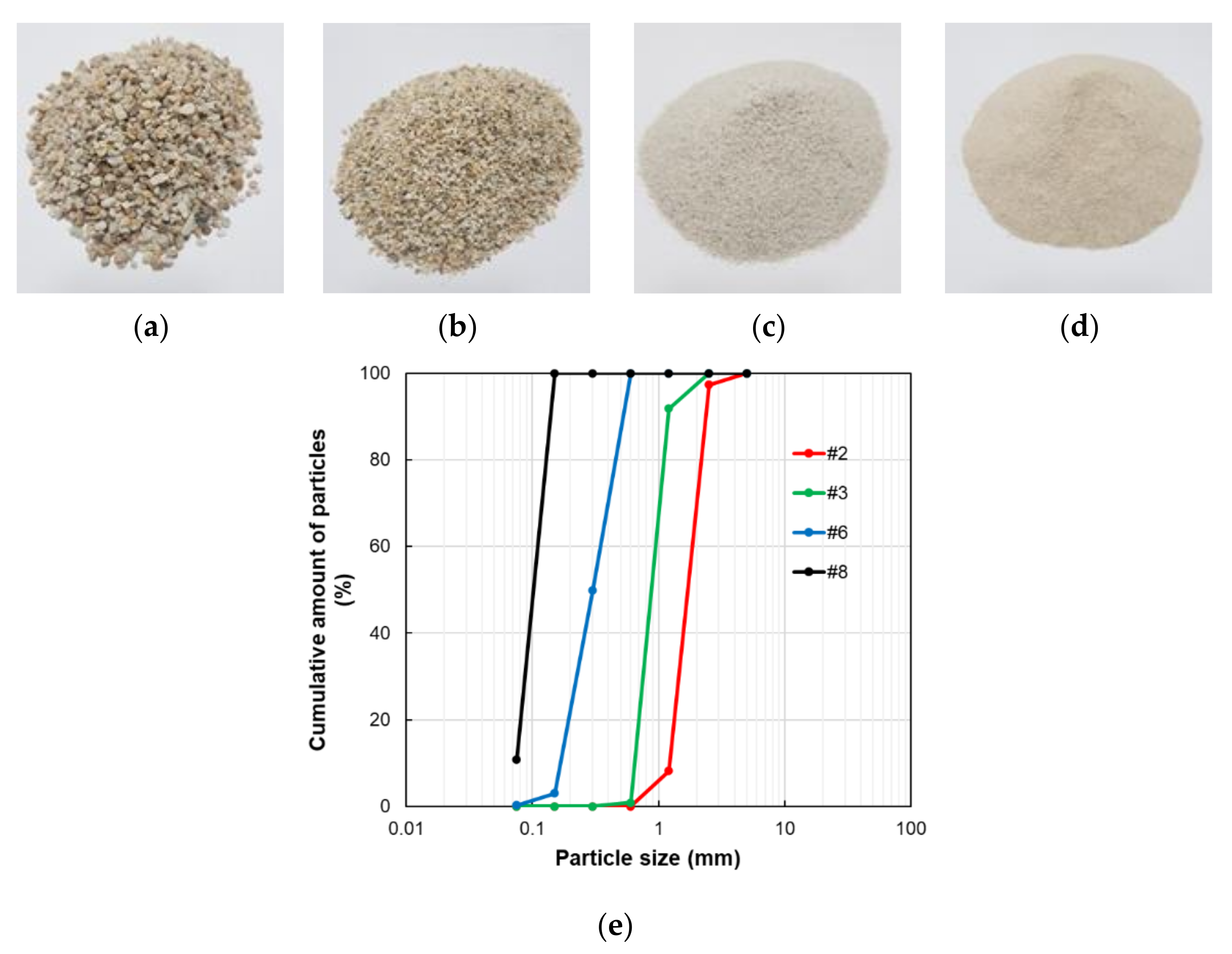
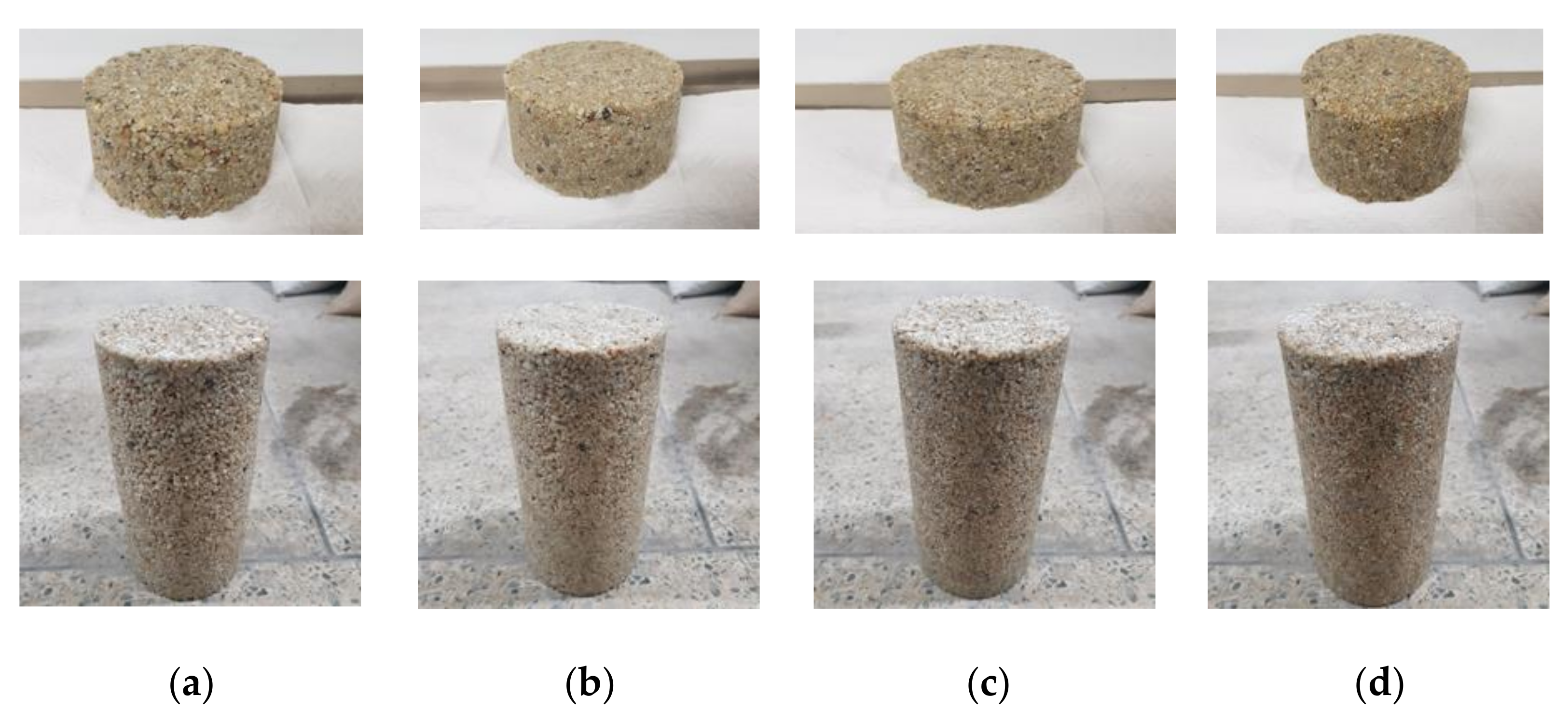
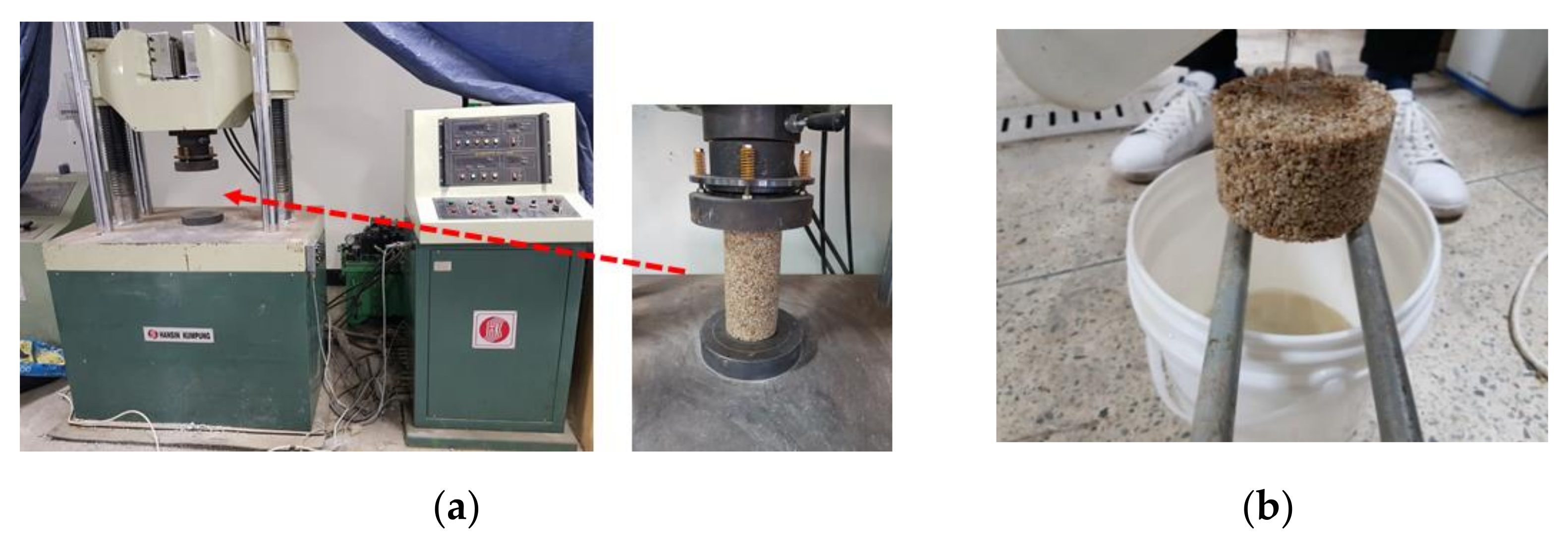
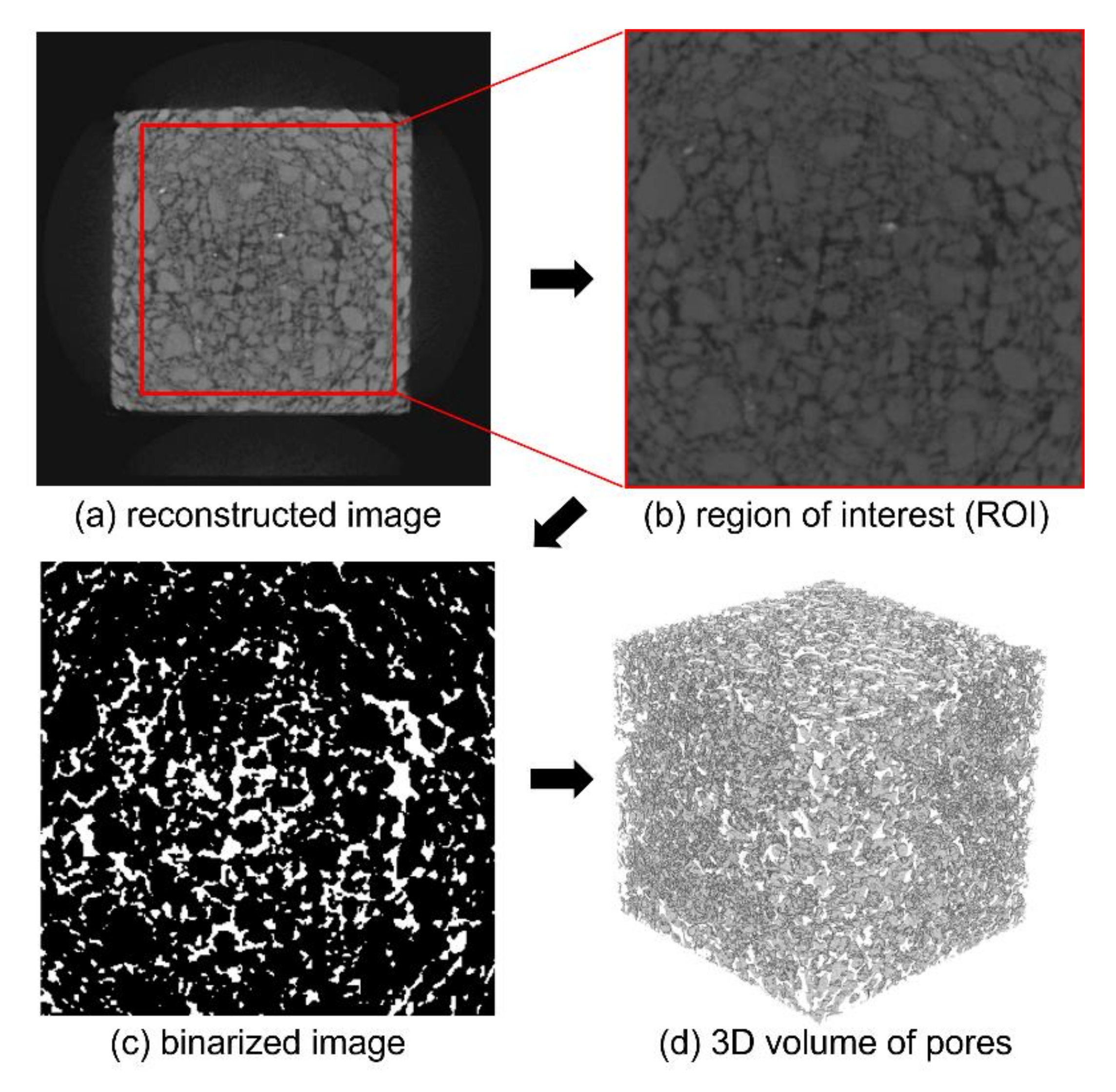

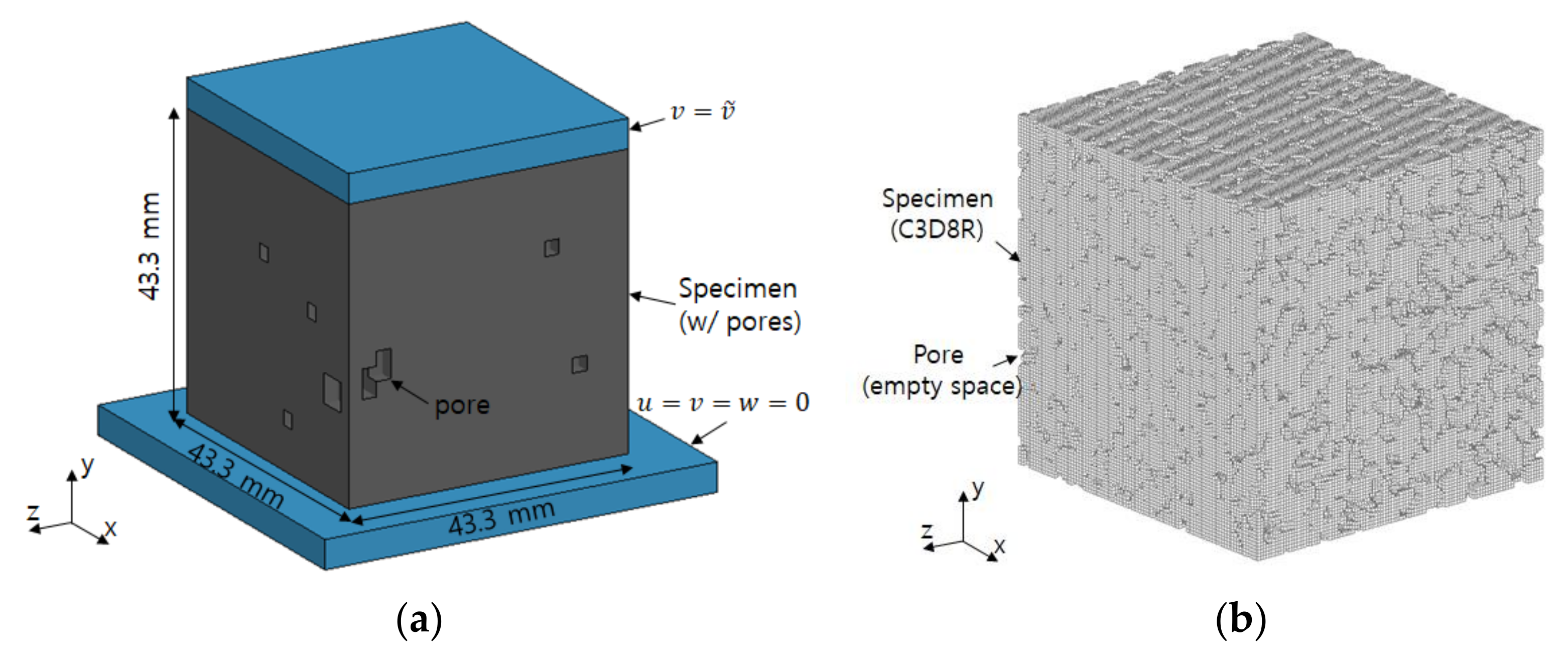
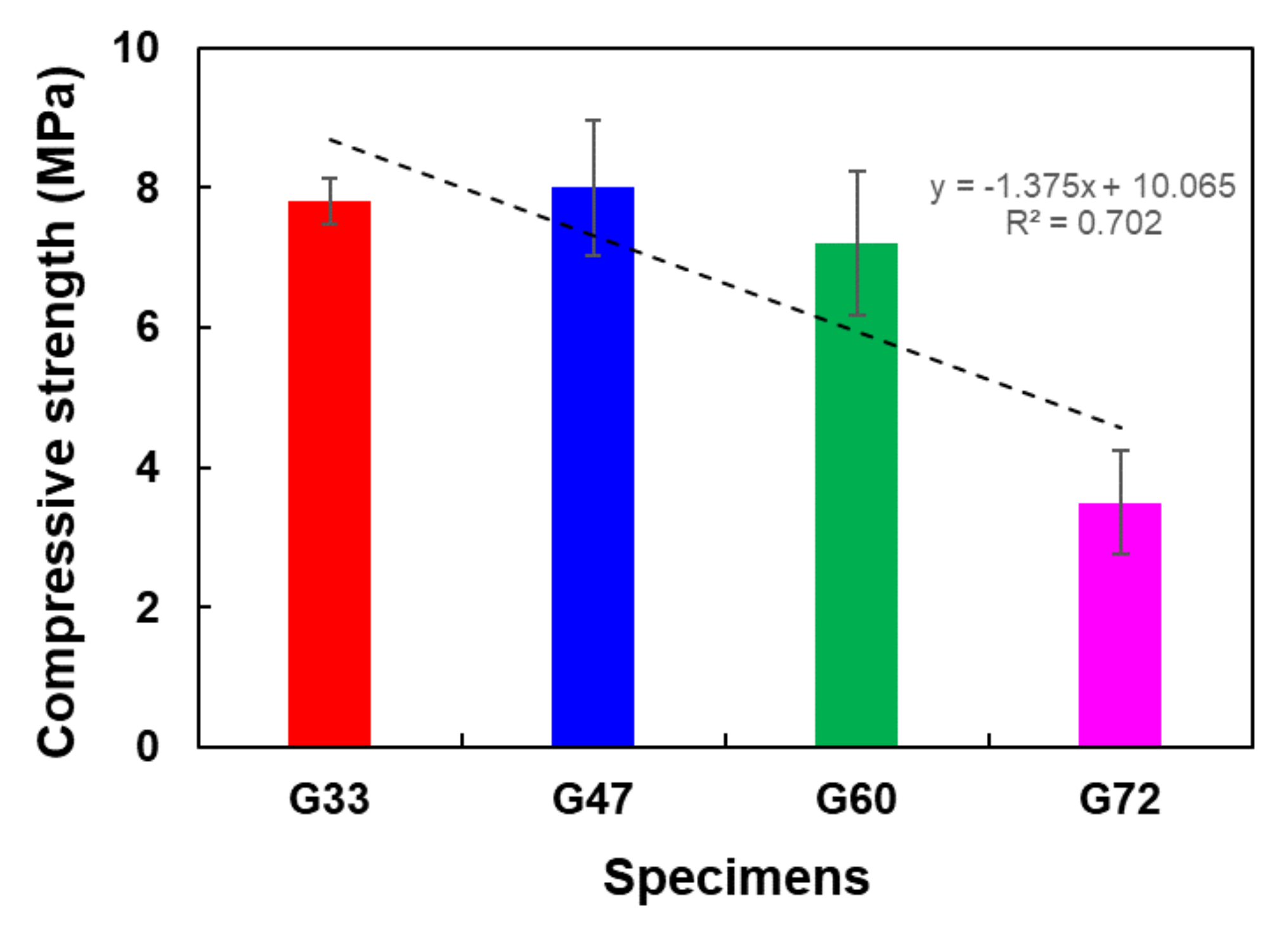
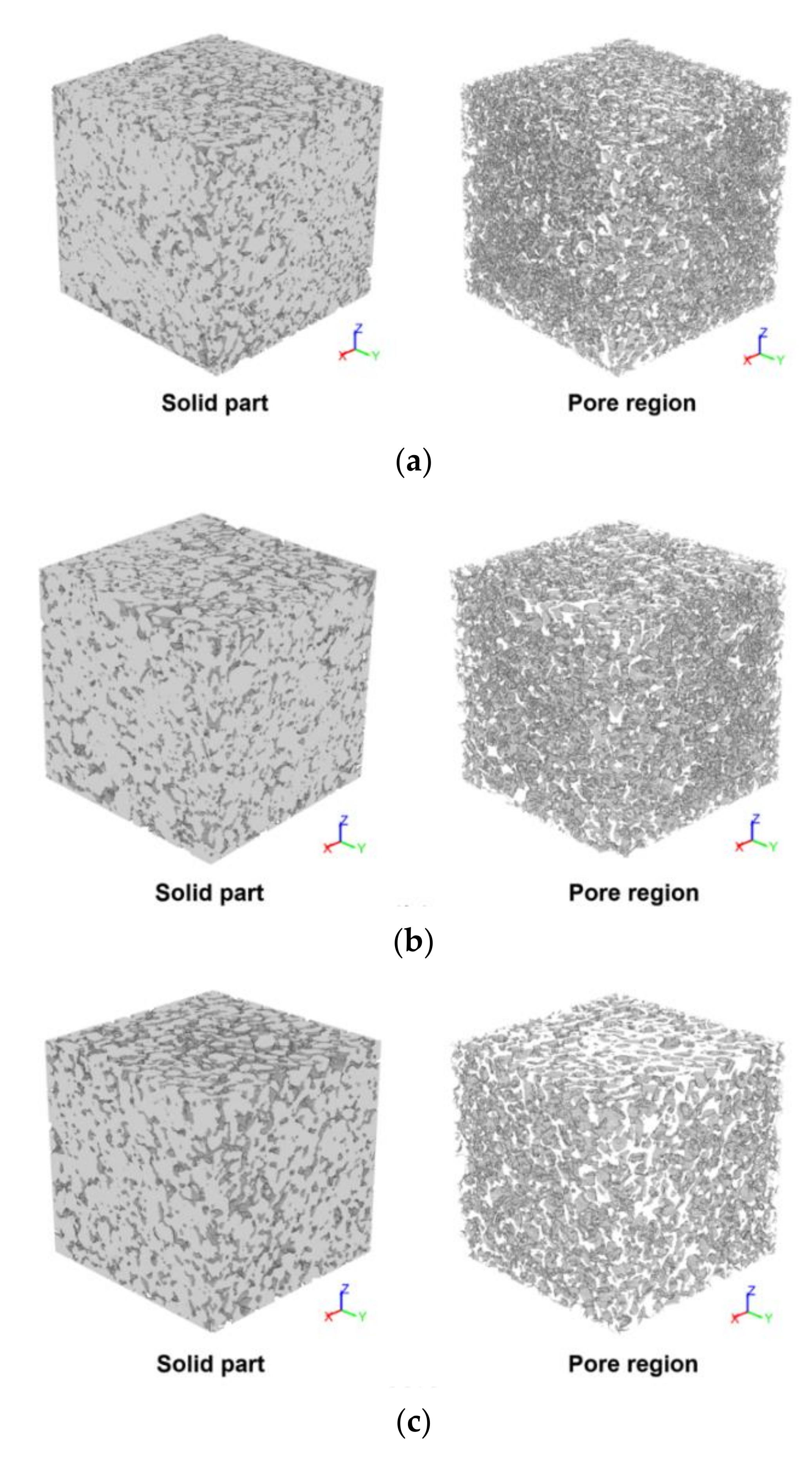
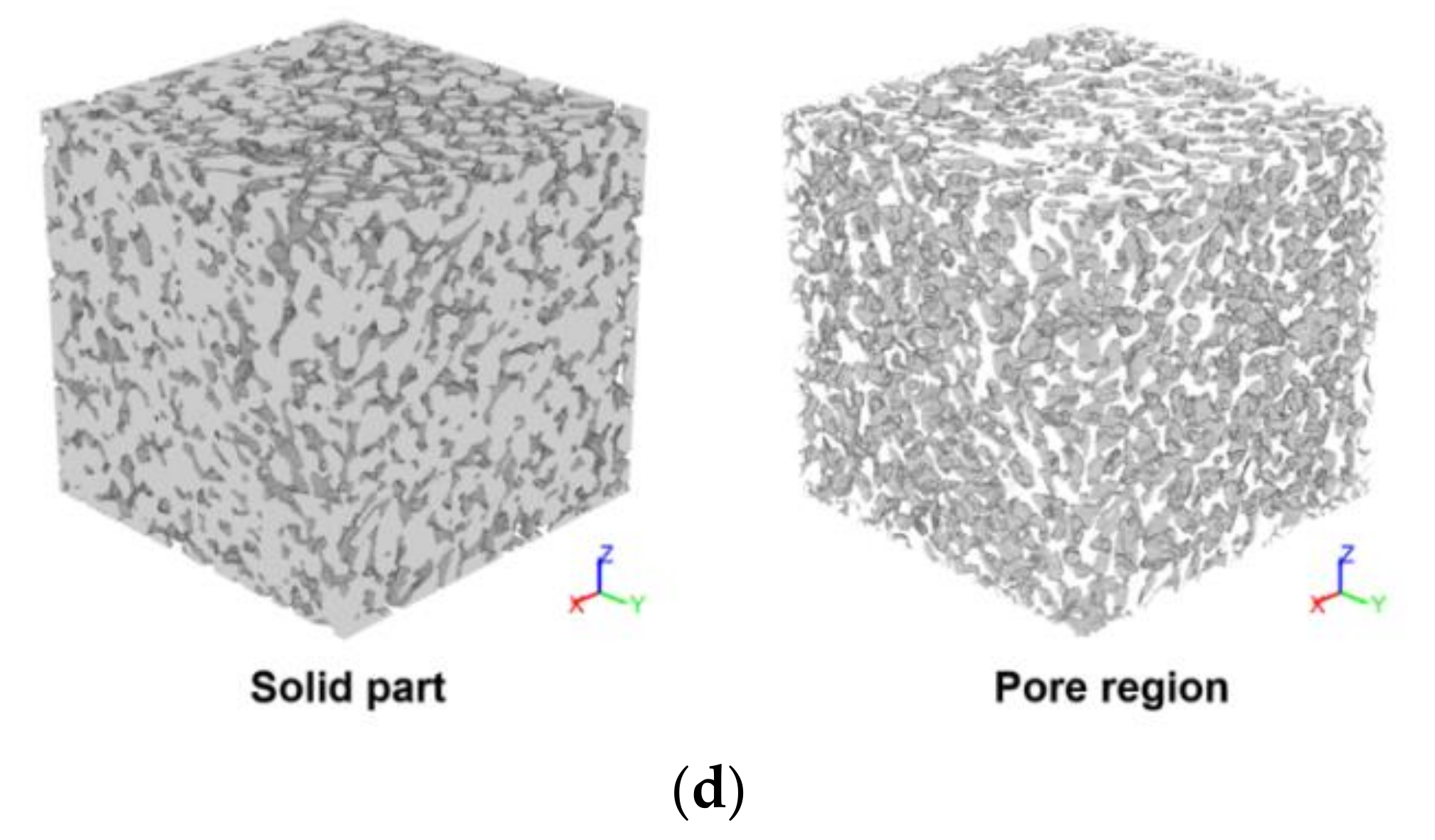
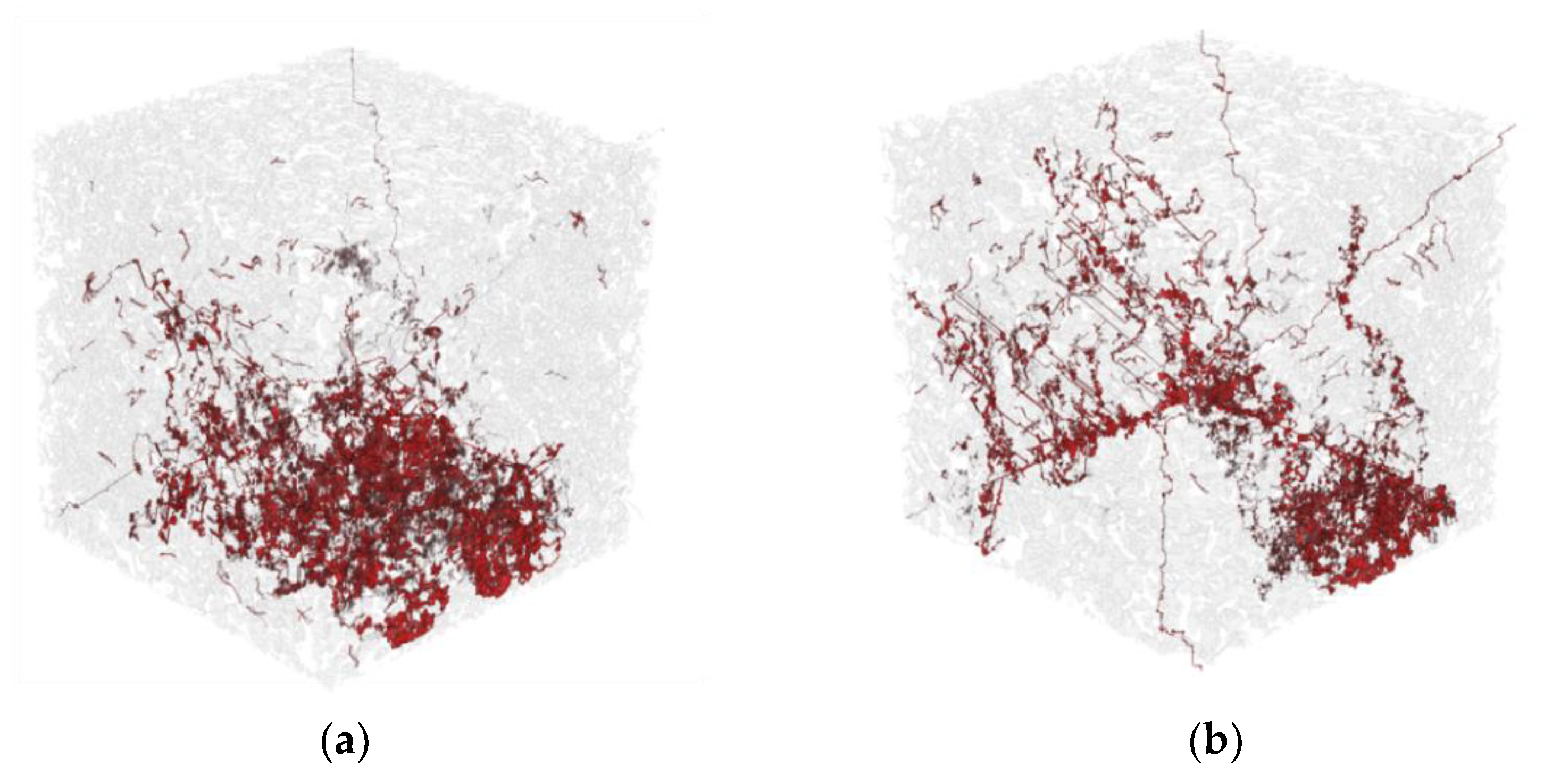
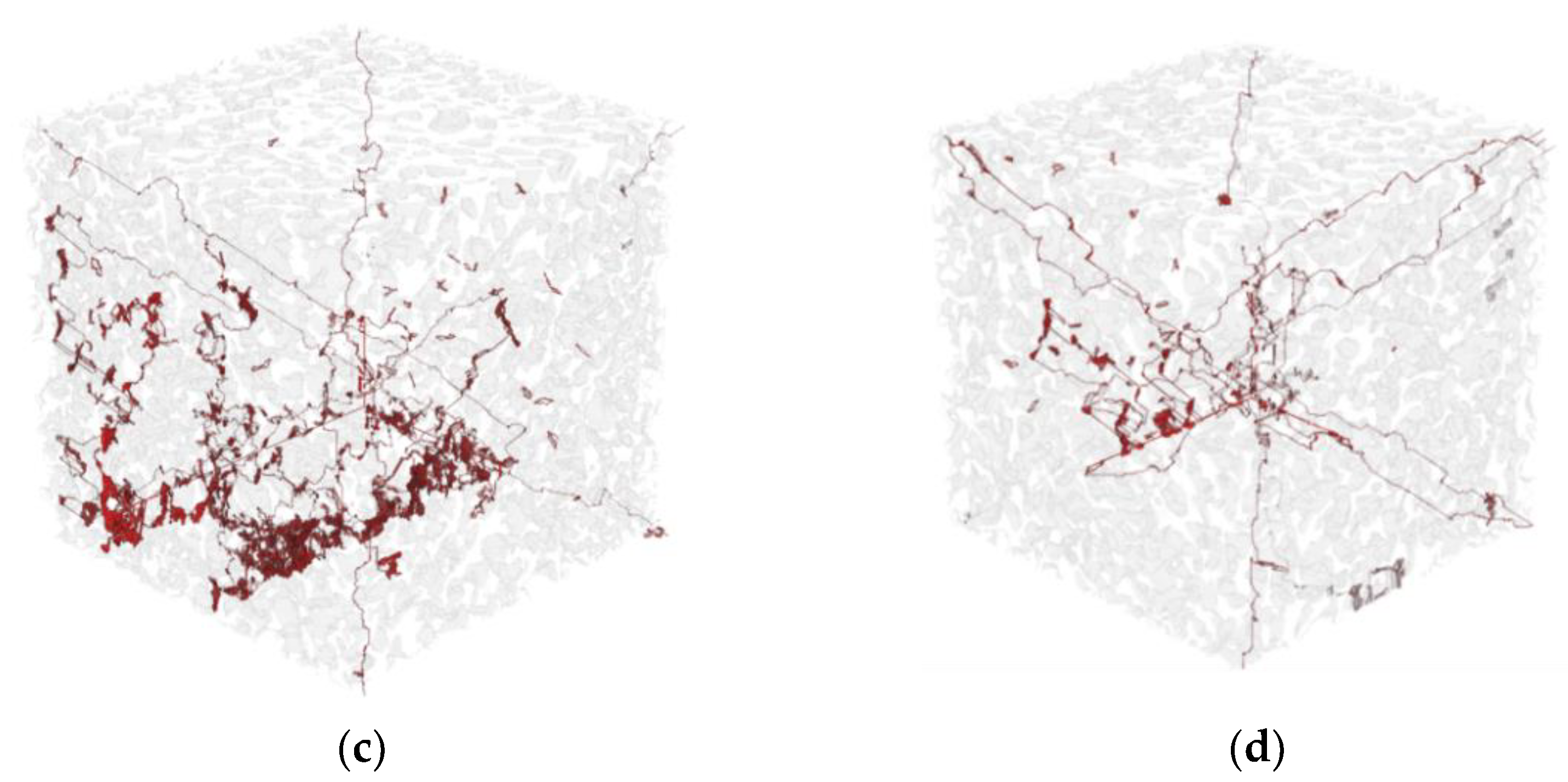

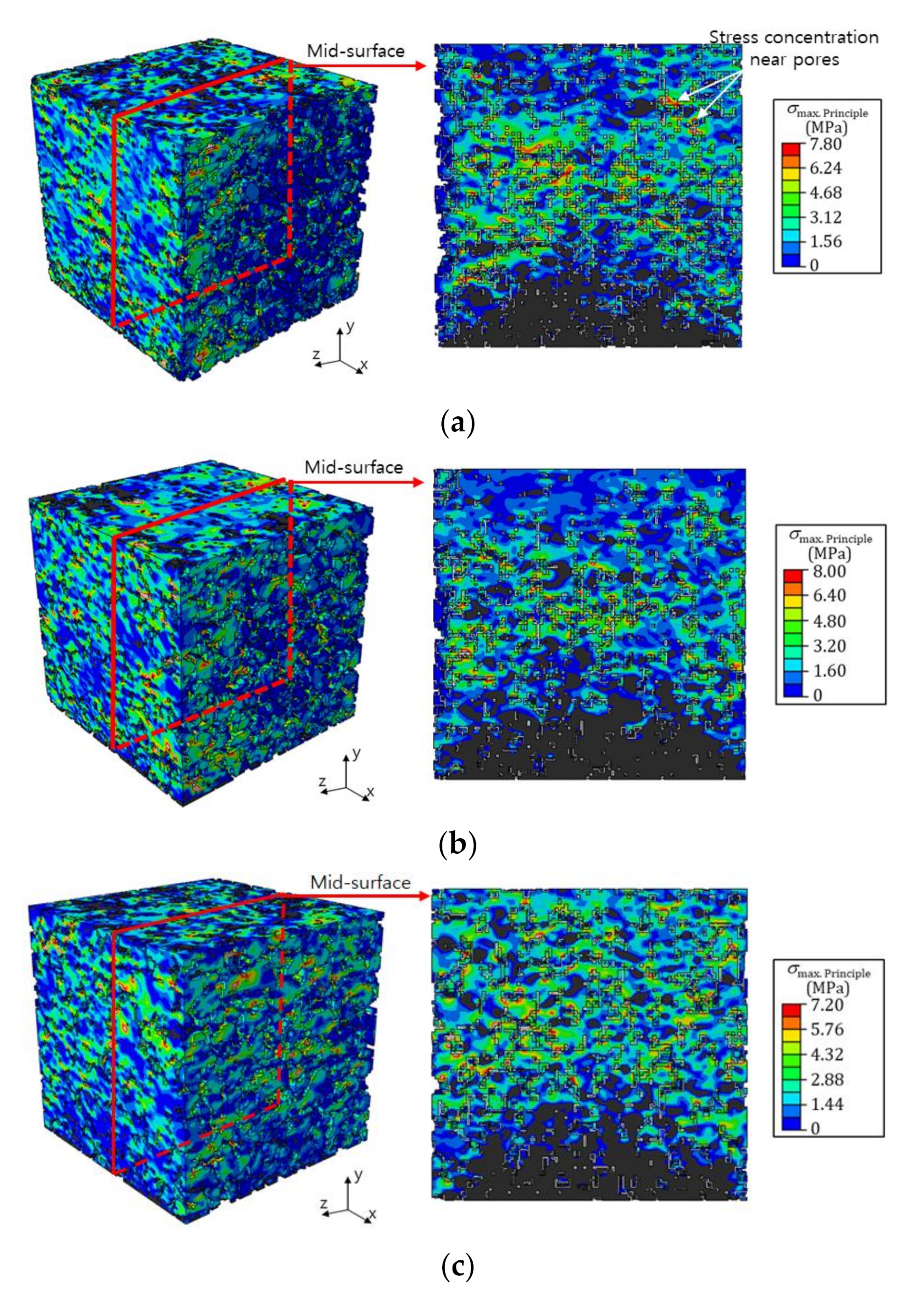
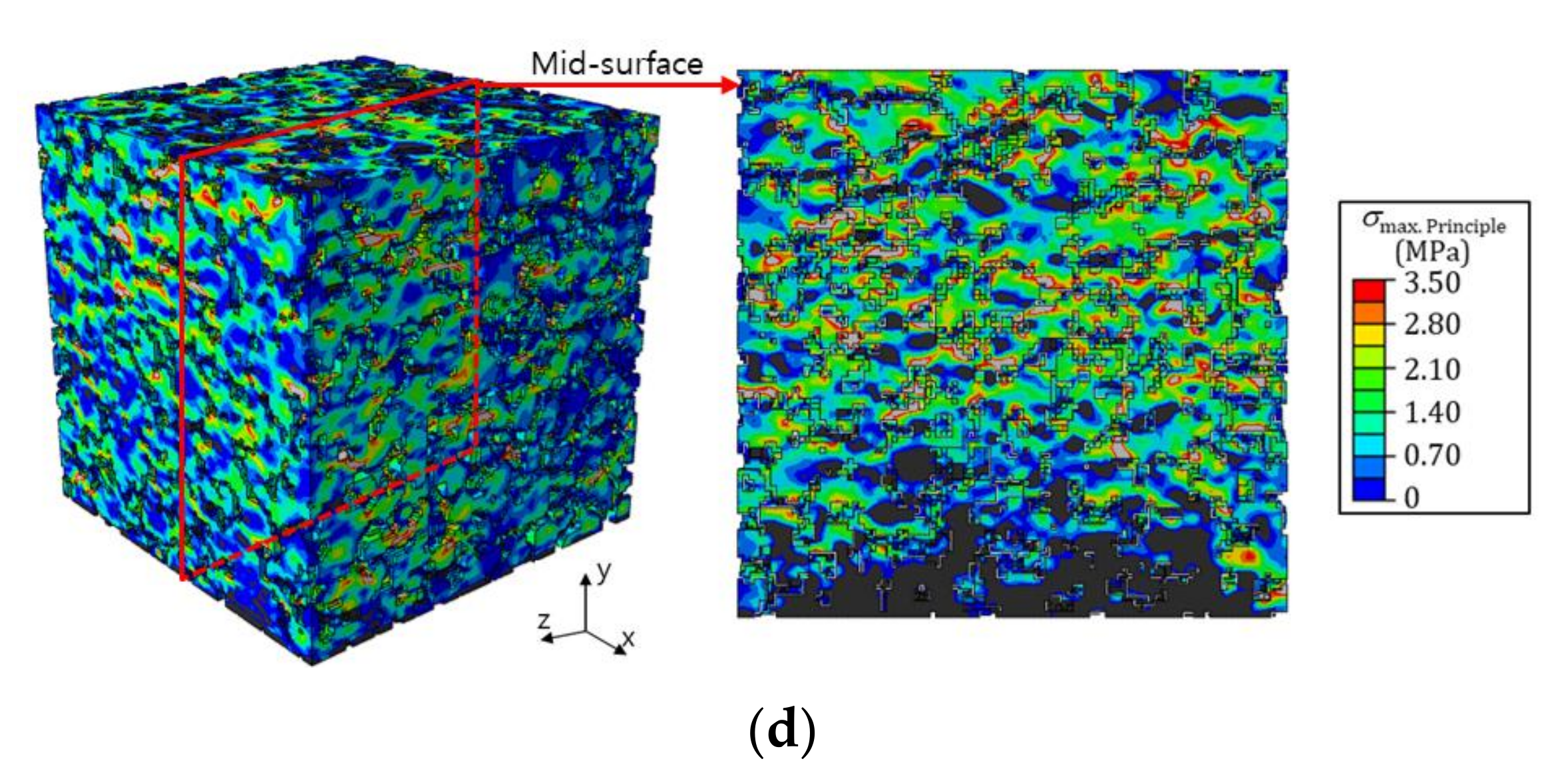
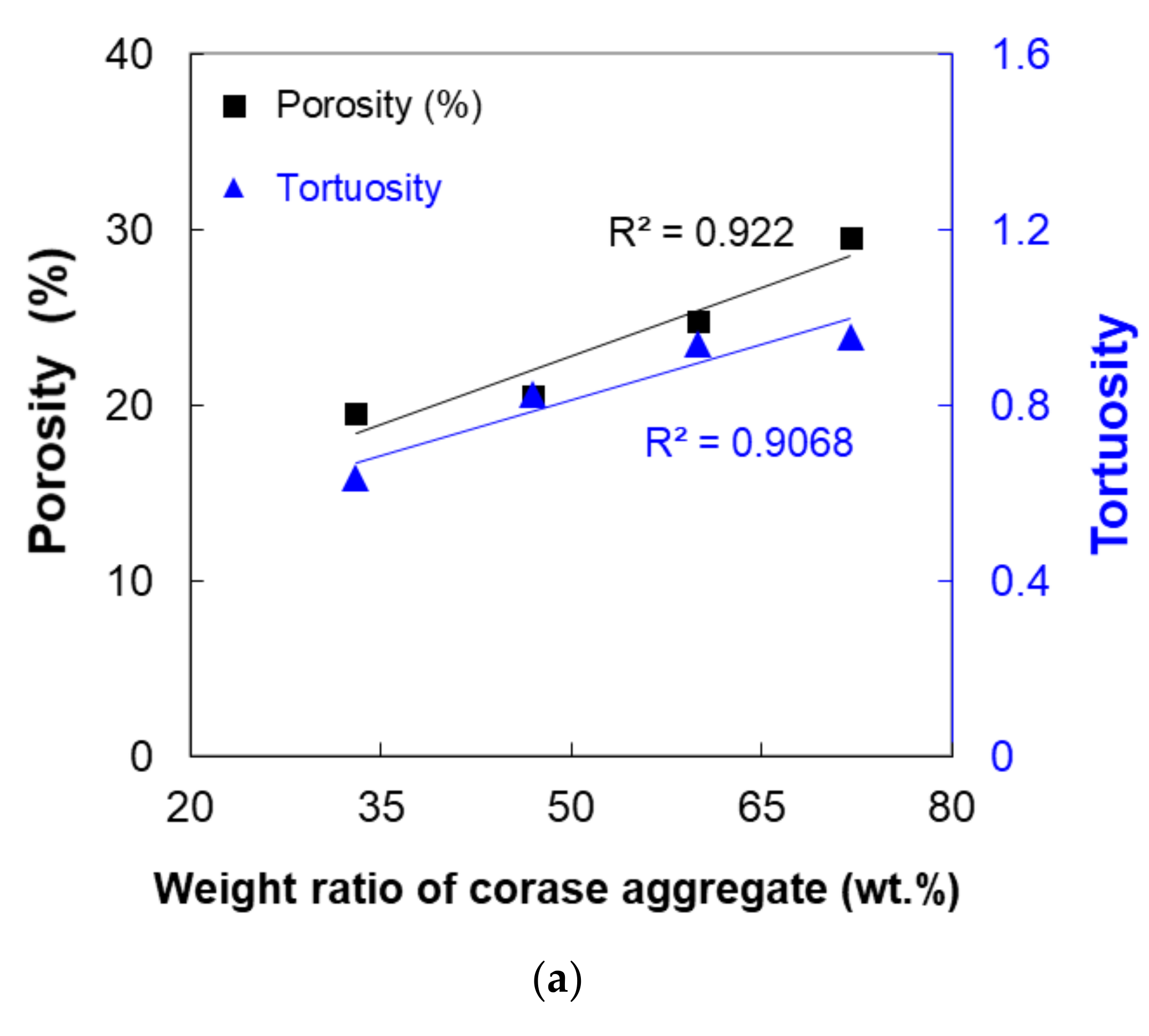

| Chemical Composition | SiO2 | Al2O3 | TiO2 | Fe2O3 |
|---|---|---|---|---|
| Concentration (wt.%) | 94.8 | 2.31 | 0.06 | 0.98 |
| Specimen | Weight Ratio of Aggregate (wt.%) 1 | B/A 2 | |||
|---|---|---|---|---|---|
| #2 | #3 | #6 | #8 | ||
| G33 | 0.33 | 0.33 | 0.33 | 0.00 | 0.09 |
| G47 | 0.47 | 0.27 | 0.27 | 0.00 | |
| G60 | 0.60 | 0.20 | 0.20 | 0.00 | |
| G72 | 0.72 | 0.18 | - | 0.09 | |
| Specimens | ||||
|---|---|---|---|---|
| G33 | G47 | G60 | G72 | |
| Compressive strength (MPa) | 7.8 ± 0.31 | 8.0 ± 0.97 | 7.2 ± 1.03 | 3.5 ± 0.74 |
| Water permeability | X | X | O | O |
| Specimens | ||||
|---|---|---|---|---|
| G33 | G47 | G60 | G72 | |
| Compressive strength (MPa) | 7.8 ± 0.31 | 8.0 ± 0.97 | 7.2 ± 1.03 | 3.5 ± 0.74 |
| Porosity (%) | 19.55 | 20.55 | 24.81 | 29.5 |
| Representative value of tortuosity | 0.63 | 0.82 | 0.94 | 0.96 |
Publisher’s Note: MDPI stays neutral with regard to jurisdictional claims in published maps and institutional affiliations. |
© 2021 by the authors. Licensee MDPI, Basel, Switzerland. This article is an open access article distributed under the terms and conditions of the Creative Commons Attribution (CC BY) license (https://creativecommons.org/licenses/by/4.0/).
Share and Cite
Cho, H.; Bae, H.; Park, C.; Park, H.M.; Oh, S.-E.; Chung, S.-Y.; Yang, B. Mechanical and Microscopic Characteristics of Polyurethane-Based Pervious Pavement Composites. Materials 2021, 14, 4365. https://doi.org/10.3390/ma14164365
Cho H, Bae H, Park C, Park HM, Oh S-E, Chung S-Y, Yang B. Mechanical and Microscopic Characteristics of Polyurethane-Based Pervious Pavement Composites. Materials. 2021; 14(16):4365. https://doi.org/10.3390/ma14164365
Chicago/Turabian StyleCho, Hongdong, Hongsu Bae, Chanho Park, Hyeong Min Park, Seo-Eun Oh, Sang-Yeop Chung, and Beomjoo Yang. 2021. "Mechanical and Microscopic Characteristics of Polyurethane-Based Pervious Pavement Composites" Materials 14, no. 16: 4365. https://doi.org/10.3390/ma14164365
APA StyleCho, H., Bae, H., Park, C., Park, H. M., Oh, S.-E., Chung, S.-Y., & Yang, B. (2021). Mechanical and Microscopic Characteristics of Polyurethane-Based Pervious Pavement Composites. Materials, 14(16), 4365. https://doi.org/10.3390/ma14164365






